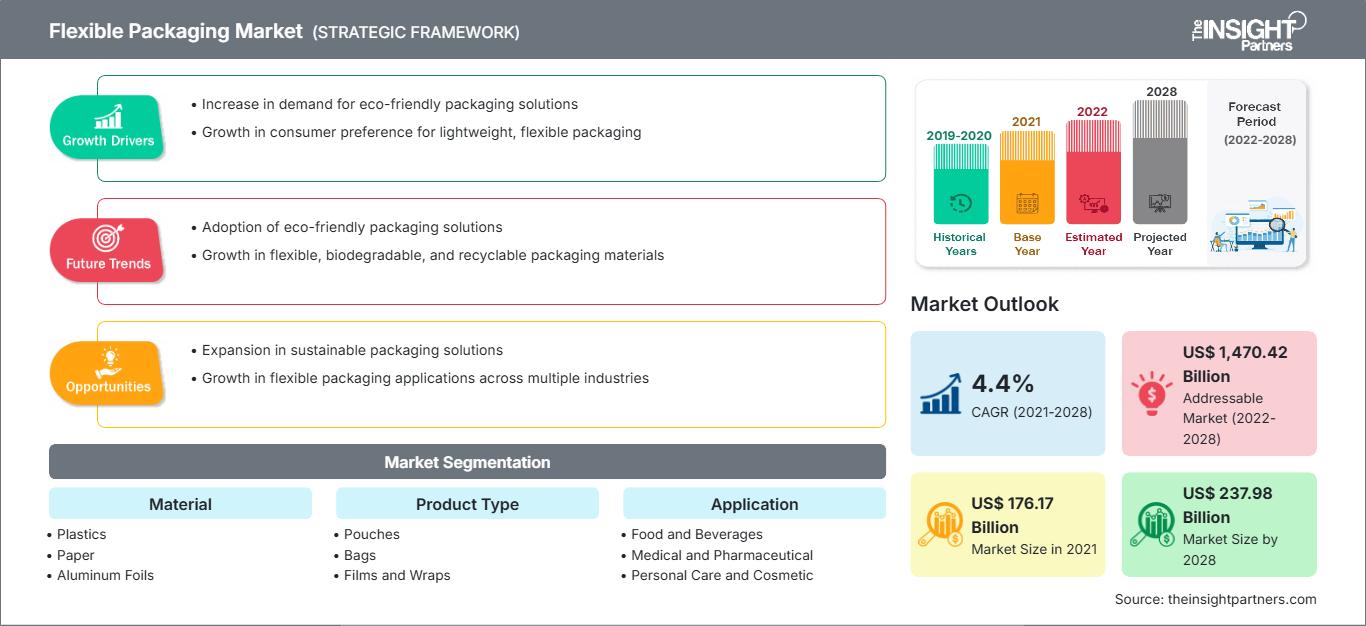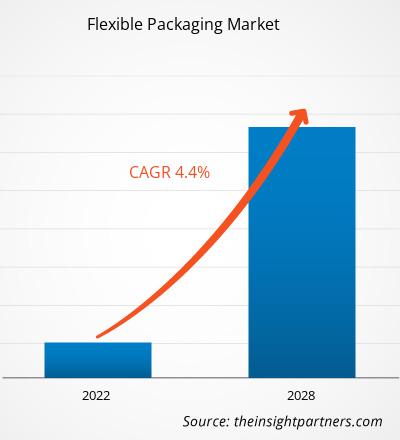预计到 2028 年,软包装市场规模将从 2021 年的 1,761.7361 亿美元增至 2,379.7567 亿美元;预计 2021 年至 2028 年的复合年增长率为 4.4%。
软包装包括内衬、包装袋、密封件、样品包和包装袋。它可以由薄膜、塑料、纸张、箔纸等制成。它用于各种食品和饮料、消费品、音乐 CD、药品、计算机软件包和营养保健品。软包装的耐用性使制造商能够印刷醒目的高质量定制设计,从而提高产品在零售环境中的知名度。
2020 年,亚太地区在全球软包装市场中占据最大收入份额。根据亚太经济合作组织的数据,澳大利亚是亚太地区的发达国家之一。食品和饮料是亚太地区最大的市场。饮料行业是澳大利亚最大的制造业,占该国制造业总营业额的32%。根据澳大利亚食品杂货委员会2019年行业状况报告,食品饮料、杂货和新鲜农产品行业价值853.2亿美元。该行业由15,000家各种规模的企业组成,雇佣了超过273,000名员工。食品饮料行业的蓬勃发展推动了软包装市场的发展。
自定义此报告以满足您的要求
您将免费获得任何报告的定制,包括本报告的部分内容,或国家级分析、Excel 数据包,以及为初创企业和大学提供超值优惠和折扣
软包装市场: 战略洞察

-
获取本报告的主要市场趋势。这个免费样本将包括数据分析,从市场趋势到估计和预测。
新冠疫情对软包装市场的影响
制造工厂停工、原材料采购困难、物流受限等因素对软包装市场产生了负面影响。然而,新冠疫情也导致线上食品配送业务激增。此外,随着消费者急于补充食品库存,包装食品和饮料行业对包括乳制品在内的耐储存食品和饮料的需求激增。数百万家庭开始在线购买食品杂货,然后自取或送货上门,许多家庭在危机过后仍将继续使用电商方式。此外,对加工食品(例如通常使用高阻隔、优质包装材料以延长保质期的方便型食品)的需求不断增长,这将刺激对软包装的需求。
市场洞察
加工食品和饮料消费量增加
饮料根据 Anu Food Brazil 的报告,2019 年巴西食品零售业的总收入为 960 亿美元。巴西食品饮料行业在 2019 年实现了 6.7% 的增长,2020 年实现了 12.8% 的增长。巴西的冷冻食品市场蓬勃发展。由于中产阶级的扩大、购买力的上升以及全职工作人数的增加,巴西的冷冻食品市场蓬勃发展。因此,消费者对方便食品的偏好日益增长,推动了软包装市场的发展。
材料行业洞察
根据材料,全球软包装市场细分为塑料、纸张、铝箔等。2020 年,塑料行业在全球软包装市场中占有最大份额。软塑料包装涉及用于包装不同产品的各种类型的塑料材料。包装所用材料的类型取决于包装产品的用途和类型。通常,软包装使用聚乙烯、聚丙烯、聚苯乙烯和聚氯乙烯等塑料材料。软包装被认为是保存、配送和包装食品、饮料、药品和多种消费品最便捷、最经济的方式。
全球软包装市场的主要参与者包括Amcor plc、Huhtamaki、Mondi、Berry Global Inc.、Sealed Air、Sonoco Products Company、Coveris、Constantia flexibles、Flexpak services和Transcontinental Inc.。市场参与者高度专注于开发高质量和创新的产品,以满足客户的需求。
软包装
软包装市场区域洞察
The Insight Partners 的分析师已详尽阐述了预测期内影响软包装市场的区域趋势和因素。本节还探讨了北美、欧洲、亚太地区、中东和非洲以及南美和中美洲的软包装市场细分和地域分布。
软包装市场报告范围
| 报告属性 | 细节 |
|---|---|
| 市场规模 2021 | US$ 176.17 Billion |
| 市场规模 2028 | US$ 237.98 Billion |
| 全球复合年增长率 (2021 - 2028) | 4.4% |
| 历史数据 | 2019-2020 |
| 预测期 | 2022-2028 |
| 涵盖的领域 |
By 材料
|
| 覆盖地区和国家 |
北美
|
| 市场领导者和主要公司简介 |
|
软包装市场参与者密度:了解其对业务动态的影响
软包装市场正在快速增长,这得益于终端用户需求的不断增长,而这些需求又源于消费者偏好的不断变化、技术进步以及对产品优势的认知度不断提升等因素。随着需求的增长,企业正在扩展产品线,不断创新以满足消费者需求,并抓住新兴趋势,从而进一步推动市场增长。

- 获取 软包装市场 主要参与者概述
报告重点
- 软包装行业的发展趋势,帮助参与者制定有效的长期战略
- 发达国家和发展中国家的市场参与者采用的业务增长战略
- 2019 年至 2028 年软包装市场的定量分析
- 全球软包装需求估计
- 波特五力分析,说明行业买家和供应商的效力
- 了解竞争激烈的市场形势
- 市场趋势和前景以及推动和抑制软包装市场增长的因素
- 通过强调支撑商业利益的市场策略来协助决策过程,从而促进市场增长
- 不同节点的软包装市场规模
- 市场的详细概述和细分,以及行业动态
- 各地区软包装市场均有良好的增长机会
- 历史分析(2 年)、基准年、预测(7 年)及复合年增长率
- PEST和SWOT分析
- 市场规模、价值/数量 - 全球、区域、国家
- 行业和竞争格局
- Excel 数据集
近期报告
客户评价
购买理由
- 明智的决策
- 了解市场动态
- 竞争分析
- 客户洞察
- 市场预测
- 风险规避
- 战略规划
- 投资论证
- 识别新兴市场
- 优化营销策略
- 提升运营效率
- 顺应监管趋势






















 获取免费样品 - 软包装市场
获取免费样品 - 软包装市场